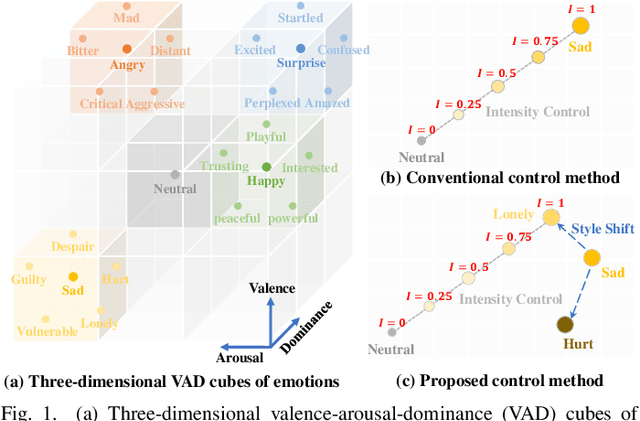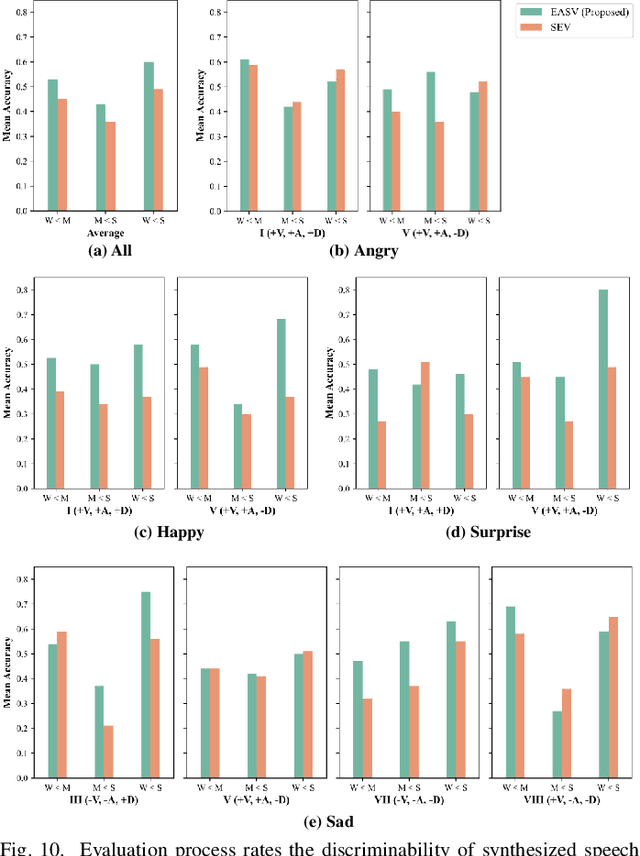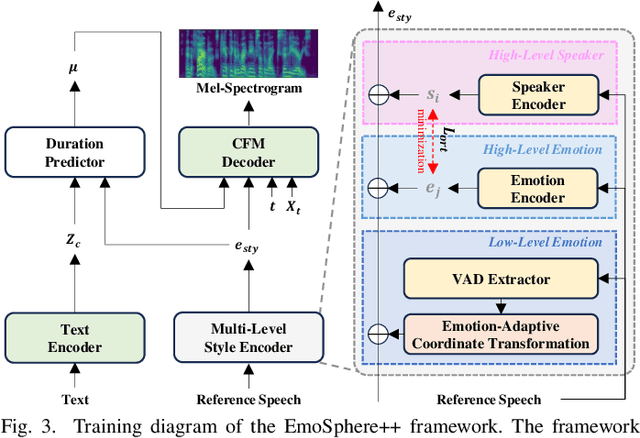Deok-Hyeon Cho
Spotlight-TTS: Spotlighting the Style via Voiced-Aware Style Extraction and Style Direction Adjustment for Expressive Text-to-Speech
May 27, 2025Abstract:Recent advances in expressive text-to-speech (TTS) have introduced diverse methods based on style embedding extracted from reference speech. However, synthesizing high-quality expressive speech remains challenging. We propose Spotlight-TTS, which exclusively emphasizes style via voiced-aware style extraction and style direction adjustment. Voiced-aware style extraction focuses on voiced regions highly related to style while maintaining continuity across different speech regions to improve expressiveness. We adjust the direction of the extracted style for optimal integration into the TTS model, which improves speech quality. Experimental results demonstrate that Spotlight-TTS achieves superior performance compared to baseline models in terms of expressiveness, overall speech quality, and style transfer capability. Our audio samples are publicly available.
DiEmo-TTS: Disentangled Emotion Representations via Self-Supervised Distillation for Cross-Speaker Emotion Transfer in Text-to-Speech
May 26, 2025Abstract:Cross-speaker emotion transfer in speech synthesis relies on extracting speaker-independent emotion embeddings for accurate emotion modeling without retaining speaker traits. However, existing timbre compression methods fail to fully separate speaker and emotion characteristics, causing speaker leakage and degraded synthesis quality. To address this, we propose DiEmo-TTS, a self-supervised distillation method to minimize emotional information loss and preserve speaker identity. We introduce cluster-driven sampling and information perturbation to preserve emotion while removing irrelevant factors. To facilitate this process, we propose an emotion clustering and matching approach using emotional attribute prediction and speaker embeddings, enabling generalization to unlabeled data. Additionally, we designed a dual conditioning transformer to integrate style features better. Experimental results confirm the effectiveness of our method in learning speaker-irrelevant emotion embeddings.
EmoSphere-SER: Enhancing Speech Emotion Recognition Through Spherical Representation with Auxiliary Classification
May 26, 2025Abstract:Speech emotion recognition predicts a speaker's emotional state from speech signals using discrete labels or continuous dimensions such as arousal, valence, and dominance (VAD). We propose EmoSphere-SER, a joint model that integrates spherical VAD region classification to guide VAD regression for improved emotion prediction. In our framework, VAD values are transformed into spherical coordinates that are divided into multiple spherical regions, and an auxiliary classification task predicts which spherical region each point belongs to, guiding the regression process. Additionally, we incorporate a dynamic weighting scheme and a style pooling layer with multi-head self-attention to capture spectral and temporal dynamics, further boosting performance. This combined training strategy reinforces structured learning and improves prediction consistency. Experimental results show that our approach exceeds baseline methods, confirming the validity of the proposed framework.
EmoSphere++: Emotion-Controllable Zero-Shot Text-to-Speech via Emotion-Adaptive Spherical Vector
Nov 04, 2024



Abstract:Emotional text-to-speech (TTS) technology has achieved significant progress in recent years; however, challenges remain owing to the inherent complexity of emotions and limitations of the available emotional speech datasets and models. Previous studies typically relied on limited emotional speech datasets or required extensive manual annotations, restricting their ability to generalize across different speakers and emotional styles. In this paper, we present EmoSphere++, an emotion-controllable zero-shot TTS model that can control emotional style and intensity to resemble natural human speech. We introduce a novel emotion-adaptive spherical vector that models emotional style and intensity without human annotation. Moreover, we propose a multi-level style encoder that can ensure effective generalization for both seen and unseen speakers. We also introduce additional loss functions to enhance the emotion transfer performance for zero-shot scenarios. We employ a conditional flow matching-based decoder to achieve high-quality and expressive emotional TTS in a few sampling steps. Experimental results demonstrate the effectiveness of the proposed framework.
EmoSphere-TTS: Emotional Style and Intensity Modeling via Spherical Emotion Vector for Controllable Emotional Text-to-Speech
Jun 12, 2024Abstract:Despite rapid advances in the field of emotional text-to-speech (TTS), recent studies primarily focus on mimicking the average style of a particular emotion. As a result, the ability to manipulate speech emotion remains constrained to several predefined labels, compromising the ability to reflect the nuanced variations of emotion. In this paper, we propose EmoSphere-TTS, which synthesizes expressive emotional speech by using a spherical emotion vector to control the emotional style and intensity of the synthetic speech. Without any human annotation, we use the arousal, valence, and dominance pseudo-labels to model the complex nature of emotion via a Cartesian-spherical transformation. Furthermore, we propose a dual conditional adversarial network to improve the quality of generated speech by reflecting the multi-aspect characteristics. The experimental results demonstrate the model ability to control emotional style and intensity with high-quality expressive speech.
 Add to Chrome
Add to Chrome Add to Firefox
Add to Firefox Add to Edge
Add to Edge